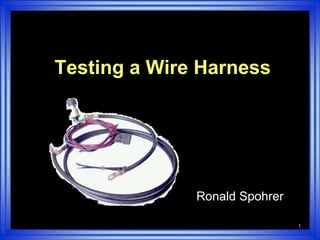
Wire Harness Test Simple
- 1. 1 Testing a Wire Harness Ronald Spohrer
- 4. 4 Testing with an Ohmmeter Test meter to make sure it is working Isolate the component or segment of the circuit that is to be tested Set the meter on the Ohm Scale. Hint: Look for the upside-down horse shoe
- 5. 5 Ohmmeter Remove the current (power/voltage) How: At the source by removing the fuse Turning off the ignition switch, that is if the circuit is controlled by the switch Disconnect from the power source, battery
- 6. 6 Ohmmeter Connect the probes or leads One at the start or beginning of the circuit and the other at the end If there is continuity (no break) the meter will show zero or low resistance. That is 000 or possibly a few ohms of resistance depending on the length of wire, connections, and number of devices in line.
- 7. 7 Ohmmeter If there is a break or open wire the meter will read 1. or UL If there is a break: Keep moving from the end back to the source to isolate the break Check each connection that is in line on that circuit
- 8. 8
- 9. 9 Testing with a Voltmeter Test the meter make sure it is working Set the meter to the DCV scale matching the circuits voltage and the vehicles This could be 6v, 12v, 24v, 36v, 48v, 120v.
- 10. 10 Voltmeter Attach the negative probe, the black lead, to the ground of the vehicle Using the positive probe, the RED lead, Start at the source of the circuit Check for voltage working from the beginning to the end of the of the circuit
- 11. 11 Voltmeter Example:start at the beginning and progress to the end of the circuit Battery Master switch Ignition switch Fuse Connections The end may be a light
- 12. 12 Voltmeter Safety Cautions Leave the ground lead (negative lead) connected at all times to a good clean spot When the circuit is energized, it may move a function of the machine Always a possible shock hazard
- 13. 13 Voltmeter If voltage (power, current) is to and through the light or end use device, but still not working, then most likely the problem is in the ground side of the circuit. If possible, check the ground connections Are they clean, tight, and in good state of repair? Replace the connection or wire as needed
- 14. 14
- 15. 15 Testing the Wiring Harness The wiring harness is the main branch with which electrical needs of a machine and its components are met Wires are commonly sheathed to protect Wires emerge at points along the frame for usage as needed by the machine
- 16. 16 Wire Harness If a bad wire is found: Individual wires can be repaired or replaced as needed Replace a wire by cutting off the ends of the defective wire and discard Run a new wire along and attach with plastic clips and electrical tape
- 17. 17 Wire Harness Always use the same size wire. A smaller wire will not carry the load and in turn will overheat or melt. Do not attempt to thread a new wire into the harness as this may damage other wires in the harness.
- 18. 18 Wire Harness Electricity needs a complete circuit to follow It will take the path of least resistance When testing a harness one needs to move the harness around when testing with your meter connected
- 19. 19 Wire harness Test for open wire (broken wire) A-D } infinite resistance A-C } infinite resistance A-B } infinite resistance
- 20. 20 Wire Harness Tests for short Bare wire touching frame A-D} zero A-C} infinite A-B} zero if wire intact but grounded A-B} infinite if wire is broken but not touching ground
- 21. 21 Wire Harness Testing for short, two wires touching A-C} zero A-B} zero A-D} zero if wires touching frame A-D} infinite if wires are not touching frame
- 22. 22
- 23. 23 Blown Fuses Not always a short Possible temporary overload (ice in fan, too many added on devices) Incorrect fuse size Poor contacts - pitted, corroded, excessive resistance
- 24. 24 Remenber Need to stress check grounds Clean, tight, free of corrosion One major reason, more and more plastic being used Probe at the connection not the wire, every extra hole in wire a place for future problems Personal safety and equipment
- 25. 25 In review Two methods of testing a harness using a Multimeter The Ohmmeter The Voltmeter